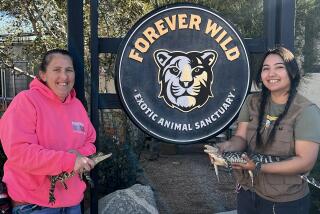Chicken Again? These Gators Get a Steady Diet of Dead Fowl
- Share via
CAMILLA, Ga. — The four low, white buildings on Mark Glass’ farm hold a powerful recycling system. Open a door to any of the rooms inside, and the system springs to life.
First there is the sound of splashing water. Then, from the darkness of the room, shapes form. They are long, low and stare out of blinking round eyes. A foul odor pervades the air.
Hundreds and hundreds of alligators fill every inch of the room. They swim toward wooden platforms suspended at the water line. These are their feeding tables, and they are hungry.
What’s for dinner? Chicken. Always chicken. Day in and day out, chicken.
Here in the heart of south Georgia poultry country, Glass has 20 chicken houses filled with 500,000 chickens. Since about 6% of chickens die before they reach maturity, there is a never-ending supply.
But instead of stoking up a fuel-guzzling, air-polluting incinerator to burn the carcasses, Glass feeds them to the alligators. Not only does he save the cost of the diesel and propane needed for the incinerator, but he has been able to launch a side business marketing the alligator meat and hides as well.
Seven of Georgia’s nine licensed alligator farmers raise the reptiles for use as “chicken disposals.” And Glass has more alligators than any of them: 10,000 at last count.
The chicken-alligator combination has a double benefit, says Greg Waters, alligator program coordinator for the Georgia Department of Natural Resources. “You’re taking a product that otherwise would be incinerated, composted or buried in a pit, and using that product to turn it into another renewable resource.”
Interest is spreading. South Carolina lawmakers recently passed a resolution to establish a three-year pilot program to study the feasibility of alligators on as many as 10 poultry farms. Farmers will bear all costs, and the Department of Natural Resources will monitor the project.
“When fuel costs went up, our farmers had to find an alternative to burning,” said state Rep. Harry Ott, who introduced the bill. “You can only bury so many dead chickens without messing up the ground water.”
Glass’ alligator farming has evolved mostly through trial and error. He started out with 1,200 hatchlings he had imported from Florida. He dug a big pond and, around the perimeter, he erected a wire fence.
But as he dumped the baby gators into the pond, his mother-in-law asked: “Are you sure those alligators are not going through that fence?”
Glass took one of the hatchlings to the fence and put it down. “He walked right through,” Glass recalls. “I took all my money out of the bank to buy these alligators, and I could see it all walking into the woods.”
A hardware store owner opened up that night and sold Glass every piece of chicken wire and every twist tie in his stock. Friends and neighbors helped secure the fence. Glass thinks he found all the runaways.
That same pond now is home to most of the larger alligators, including a 13-footer. Smaller ones, up to 4 feet long, stay in the holding houses Glass has designed.
The temperature inside is a constant 90 degrees, and the alligators spend almost all their time in shallow pools. Sorted by size, they live in the dark. “It keeps them calm,” Glass explains.
The real challenge for Glass is finding employees. “Not many people want to work in a chicken house, but really not many want to work with alligators. Most of them are scared.”
The majority of the alligators are harvested when they reach 4 feet. Glass and his crew walk into the pools, reach down, grab them by their tails and quickly tape their mouths shut.
Glass has had one close call. He had a 4-footer by the tail and was about to reach under the water and grab its neck. “He just bent in half. He was lightning fast,” Glass says. “He just snapped at me and let go. He did not draw any blood, but it scared me to death.”
The most valuable part of an alligator is its hide. Glass gets from $50 to $150 a hide--depending on size and quality. Representatives of French, Italian and South African tanneries have offered to buy his entire stock. No scuffs or blemishes mar the shiny black and white skins.
The vinyl lining of the pools keeps the hides free of scrapes, Glass says. He learned early that alligators living in water have fewer fights. Fights cause scratches and bite marks on the hides.
Glass also markets alligator meat. He says it tastes like chicken, with a hint of fish. Restaurants and seafood shops across the Southeast pay $5 a pound for filets.
Chicken farmers from as far away as Britain have called Glass, seeking advice on adding alligators to their farms.
“I got into this with the attitude that, if I could just get rid of my dead chickens, I’d be ahead of the game,” Glass says as he rubs a hand down a salted alligator hide. For five years he has reinvested funds to buy more alligators, build and improve their houses and market the meat and hides. Alligator farming is an expensive operation, he says. “It’s not a one-year return on investment. It’s probably a five- or six-year return.” This year, for the first time, he expects to turn a profit.
More to Read
Sign up for Essential California
The most important California stories and recommendations in your inbox every morning.
You may occasionally receive promotional content from the Los Angeles Times.













